by Lisa Cooke | May 9, 2016 | 01 What's New, Ancestry, DNA
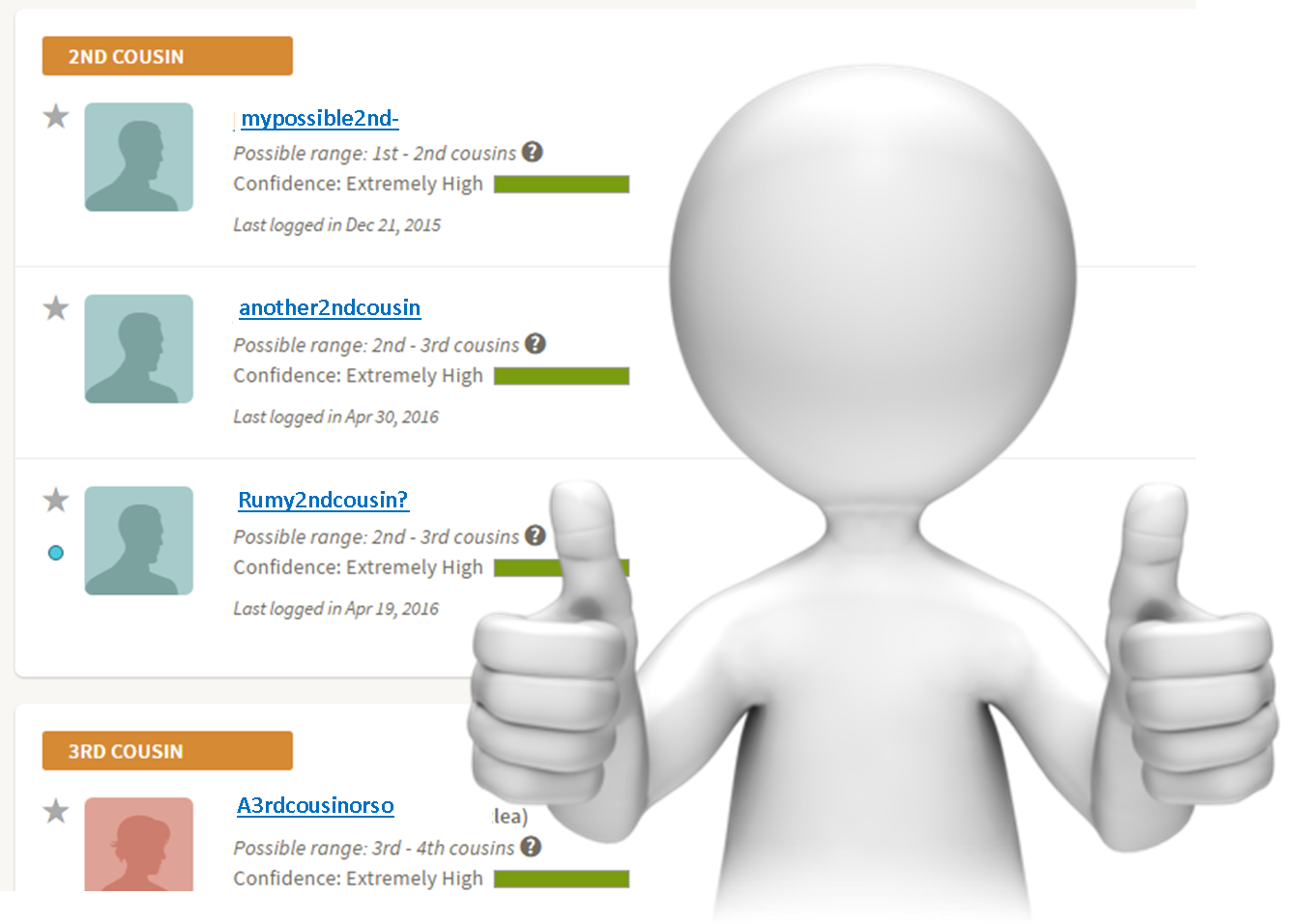 Double good news: AncestryDNA has made some improvements to the way they calculate your genetic matches, but they haven’t messed with the site format or layout. There is one downside–so keep reading.
Double good news: AncestryDNA has made some improvements to the way they calculate your genetic matches, but they haven’t messed with the site format or layout. There is one downside–so keep reading.
Change is afoot at AncestryDNA. Again.
While stability and predictability seem like honorable qualities in a company or product, when it comes to tech tools, in the ears of tech companies, those words sound more like dated and old. Of course, we are used to this by now. I had a client tell me recently that he wanted to be in touch sooner, but his grandson “upgraded” his computer to Windows 10 and then promptly left for college the next day, leaving him fighting with a new interface and operating system.
The good news is, you won’t have this problem with Ancestry’s new update. There aren’t any changes to the interface or the layout of the information. In fact, many of you will not even notice at first that your match list has changed. You’ll just see this notification when you log in:

But in fact, there likely have been some adjustments made to your match results:
- Some of your third cousins have been demoted to fourth cousins.
- Some of your fourth cousins have been demoted to 5th-8th cousins.
- Some of your Distant Cousins have disappeared off your match list
- You have new cousins on your Distant Cousin match list.
In general, from what Ancestry has showed us, you gain more than you lose.
Changes in the dregs of your match list may not seem like that big of a deal. But Ancestry has made some big changes in the way that they are calculating matches. They are getting better at it. Which means you match list is now more representative of your ancestral connections, even at the very distant level.
There are two big pieces to this matching puzzle that Ancestry has tinkered with in this latest update: phasing and matching.
You will remember our discussion on DNA phasing and how it can impact your matching. Ancestry has developed a robust reference database of phased DNA in order to better phase our samples. Basically, they have looked through their database at parent-child duos and trios and noted that certain strings of DNA values often travel together. It’s like they have noticed that our DNA says “A black cat scared the mouse” instead of “The brown cat ate the mouse” and they can then recognize that phrase in our DNA, which in turn helps our DNA tell the true story of our heritage.
In addition to updating the phasing, Ancestry has revamped their matching method. In the past they viewed our DNA in small windows of information, and then stitched those windows together to try to get a better picture of what our DNA looked like. Now instead they have turned to a point-by-point analysis of our DNA. Again to use a sentence example, with the window analysis we may have the following sentence windows:
ack and J
ill went t
he hill t
etch a pai
l of water.
 Of those windows, you may share the “etch a pai” with another individual in the database, earning that cousin a spot on your match page. However, the truth is, that bit could say “sketch a painting” or “stretch a painful leg” or “fetch a pail.” With Ancestry’s new method, they are able to see farther on either side of the matching segment, making this clearly “fetch a pail.” That means better matching, which means more confidence in your cousin matches.
Of those windows, you may share the “etch a pai” with another individual in the database, earning that cousin a spot on your match page. However, the truth is, that bit could say “sketch a painting” or “stretch a painful leg” or “fetch a pail.” With Ancestry’s new method, they are able to see farther on either side of the matching segment, making this clearly “fetch a pail.” That means better matching, which means more confidence in your cousin matches.
The downside to this update is going to come in the reorganization of some of your relationships. Ancestry has tightened their genetic definition of your third and fourth cousins. Basically, that means that some of your true 3rd cousins are going to show up as 4th cousins, and some of your true 4th cousins are going to be shifted down into the abyss of 5th-8th cousins.
This brings us to the downside of this AncestryDNA update: changes to the Shared Matches tool. The shared matches tool allows you to gather matches in the database that are related to you and one other person, provided you are all related at the 4th cousin level or higher. This tightening of the belt on 4th cousins means that some of them are going to drop through the cracks of that tool, really limiting its ability. Grr. Hopefully, Ancestry will fix that, and expand this tool to include all of your matches. They have their fairly good reasons for this, but still….
So, as the winds of change blow yet another iteration of the AncestryDNA match page, I think we can see this as an overall win for doing genealogy with our genetics at Ancestry.
More AncestryDNA Gems

Disclosure: This article contains affiliate links and Genealogy Gems will be compensated if you make a purchase after clicking on these links (at no additional cost to you). Thank you for supporting Genealogy Gems!
by Lisa Cooke | Dec 26, 2015 | 01 What's New, Ancestry, DNA, Trees
DNA Circles at AncestryDNA can get problematic when participants’ trees are unverified. This is why.
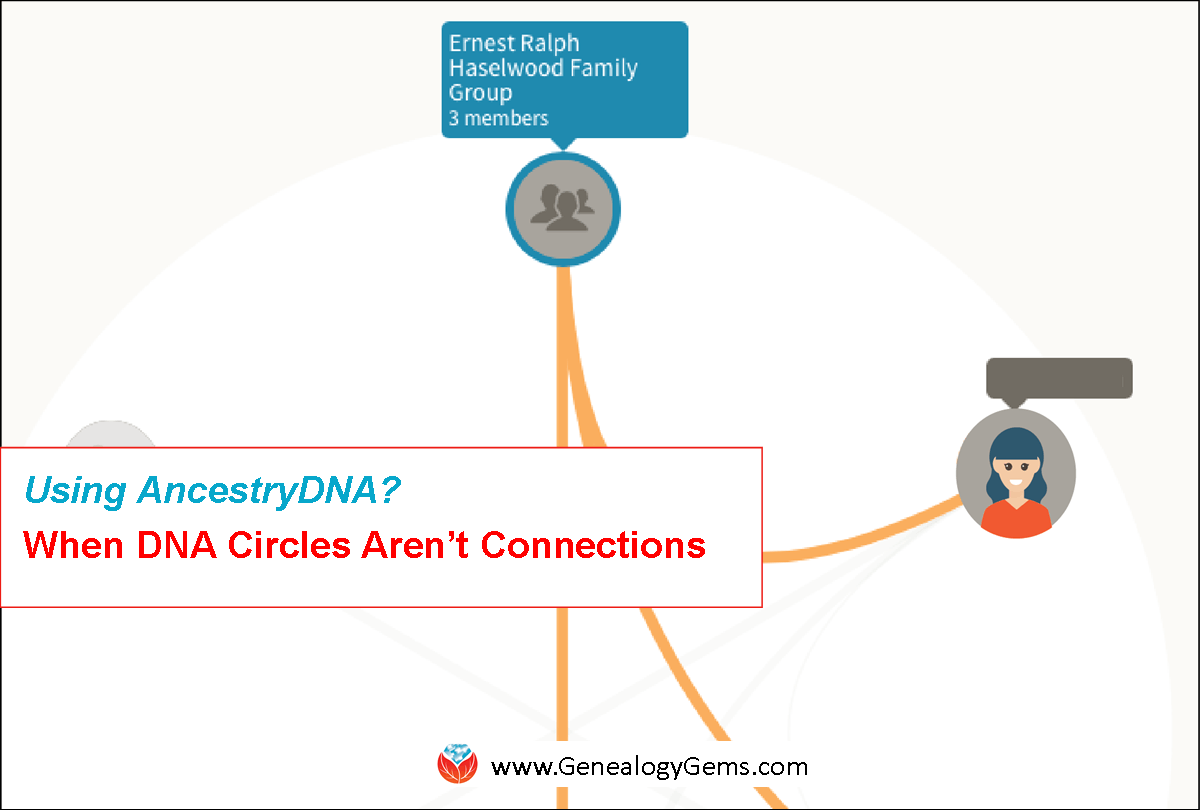
Adding people to a family tree without verifying the connection is a fairly common genealogical practice. This happens a lot when people “graft” information from another online tree.
In addition to the problems this can create in your tree, it can create problems when you start looking at genetic connections. We have received a few inquiries about this topic here at Genealogy Gems, and I chatted with a fellow genealogist about this at a recent conference.
The practice of copying online trees factors most heavily in the DNA Circles and New Ancestor Discoveries (NAD) at AncestryDNA. You will remember from our previous conversations that these tools are like parties that your DNA has secured your tickets to attend. Each of these parties is “hosted” by one of your ancestors, in the case of the DNA circle, and a presumed ancestor, in the case of a NAD. Sometimes we catch ourselves declaring that our membership in the DNA circle “proves” our connection to the party host.
But we must be careful. Because it does not.
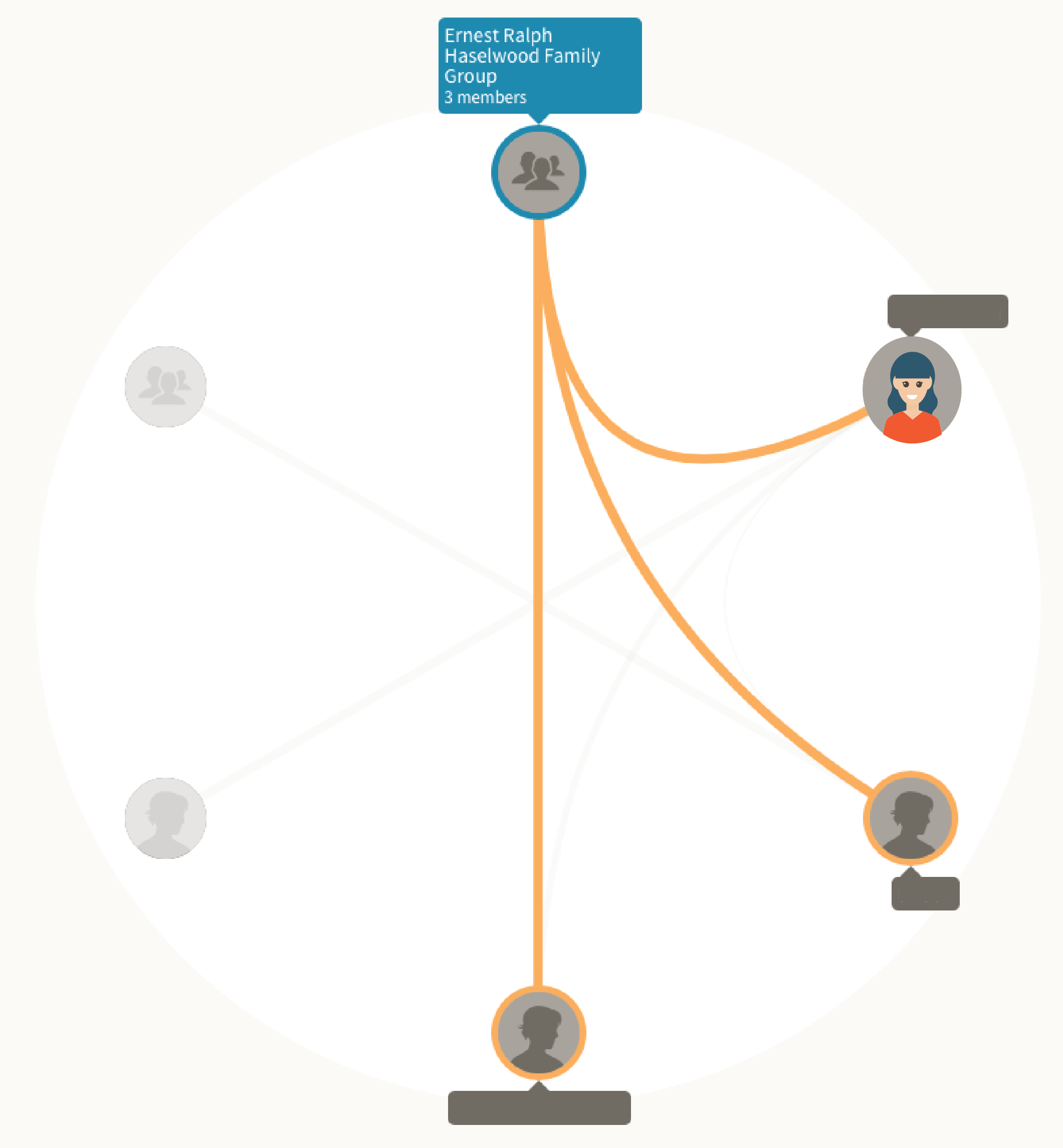 “Proves” is too strong of a word. All your membership in the DNA circle can really tell you is that you have a genetic connection to those marked with the orange line. Those with the grey connecting lines have a DNA connection to some of the circle members, but not to you. Placing the name of an ancestor on the cover of this gathering does not guarantee that the named person is your common ancestor. It is just a suggestion; a hint.
“Proves” is too strong of a word. All your membership in the DNA circle can really tell you is that you have a genetic connection to those marked with the orange line. Those with the grey connecting lines have a DNA connection to some of the circle members, but not to you. Placing the name of an ancestor on the cover of this gathering does not guarantee that the named person is your common ancestor. It is just a suggestion; a hint.
Think about this for just a second. Let’s say that Joan does a bit of research and decides that her immigrant ancestor’s father is Marcus Reese, born in 1823 in Wales. She adds this to her pedigree chart. She sees on a census record that he had four children, one of whom shared the name of her ancestor, William, and adds those to her chart as well.
Months later, Charlotte is researching her Mary Reese and sees Mary listed on Joan’s pedigree chart as the child of Marcus. She knows Mary’s father was born in Wales and adds Marcus to her pedigree chart telling herself that she will go back later and double check. And so on.
After a while, we have 7 people all connected back through Marcus and his four children, and they all independently decided to get their DNA tested through Ancestry.com.
Ancestry sees their shared DNA and that they have all listed Marcus Reese as their common ancestor. So they create a DNA circle for the seven of them, with Marcus Reese at the head.
Ancestry did not look at the number of cited sources or the myriad of other genealogical possibilities about how these seven individuals could all be related to each other. It saw a genetic connection and a genealogical hypothesis, and it presented them to you in the form of a DNA circle.
The genetic evidence supports a single common ancestor for these 7 people, but it certainly does not have to be Marcus Reese. You can become more certain as you gather the traditional genealogical evidence that you would in any other case. As your documentation mounts, so will your confidence, with the DNA acting like an invitation to keep searching for further evidence of your connection.
 If you enjoyed this post, you’ll love my series of DNA for genealogy quick guides. Each laminated guide–with quick, clear text that helps you act on what you learn–is targeted to a specific DNA topic, from “Getting Started” to the three types of DNA tests you can take to understanding your results with testing companies AncestryDNA, FamilyTreeDNA and 23andMe. Why not grab the “super bundle” of all 10 guides? You can also shop for them individually here.
If you enjoyed this post, you’ll love my series of DNA for genealogy quick guides. Each laminated guide–with quick, clear text that helps you act on what you learn–is targeted to a specific DNA topic, from “Getting Started” to the three types of DNA tests you can take to understanding your results with testing companies AncestryDNA, FamilyTreeDNA and 23andMe. Why not grab the “super bundle” of all 10 guides? You can also shop for them individually here.
Disclosure: This article contains affiliate links and Genealogy Gems will be compensated if you make a purchase after clicking on these links (at no additional cost to you). Thank you for supporting Genealogy Gems!

by Lisa Cooke | Nov 18, 2015 | 01 What's New, Ancestry, DNA
 “This is huge!” That’s how DNA expert Diahan Southard summed up major advances at AncestryDNA this past year. Her post was huge, too: it landed the #5 spot on our Top 10 genealogy blog posts for 2015 countdown. See why!
“This is huge!” That’s how DNA expert Diahan Southard summed up major advances at AncestryDNA this past year. Her post was huge, too: it landed the #5 spot on our Top 10 genealogy blog posts for 2015 countdown. See why!
To those who have spent a lot of time doing genetic genealogy, bringing up the launch of significant updates to AncestryDNA earlier this year may seem like old news. But it’s not. AncestryDNA is still the only company with fairly advanced tools for integrating your genetic matches with your family tree. That combo is so attractive, they’ve already acquired more than a million samples in their current DNA database–a huge pond in which to fish for genetic matches.
That’s why Diahan’s popular post on updates to AncestryDNA and DNA Circles is still newsworthy. As she explained, “This is really the first time a DNA testing company has so fully integrated genetics and genealogy. We can now find cousins in the database who do not share our particular genetics, but who do share some of the genetics of our common ancestor.”
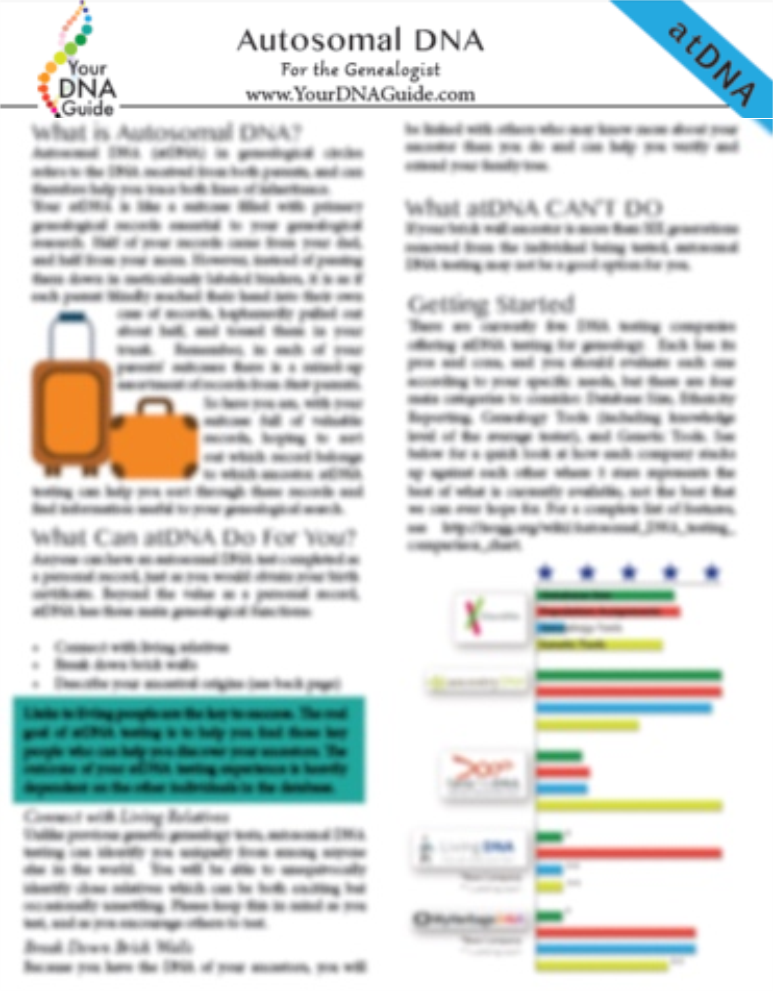 Before doing any DNA test, we always encourage genealogists to do their homework. Different tests should be used for different genealogical questions. Each company offers unique tools, perks and sometimes drawbacks for genealogy customers. Unexpected results and unpredictable encounters with genetic relatives may be difficult for some. Diahan’s Autosomal DNA for the Genealogist quick guide can help you find your way. Her other guides include those specific to AncestryDNA and autosomal DNA (the type of DNA they test at Ancestry). Click here to check them out–and see a great value price to bundle her guides.
Before doing any DNA test, we always encourage genealogists to do their homework. Different tests should be used for different genealogical questions. Each company offers unique tools, perks and sometimes drawbacks for genealogy customers. Unexpected results and unpredictable encounters with genetic relatives may be difficult for some. Diahan’s Autosomal DNA for the Genealogist quick guide can help you find your way. Her other guides include those specific to AncestryDNA and autosomal DNA (the type of DNA they test at Ancestry). Click here to check them out–and see a great value price to bundle her guides.
Once you’re ready to try an AncestryDNA test, click here to purchase, and you’ll support the free Genealogy Gem blog and podcast. (Thank you!)
Disclosure: This article contains affiliate links and Genealogy Gems will be compensated if you make a purchase after clicking on these links (at no additional cost to you). Thank you for supporting Genealogy Gems!
by Lisa Cooke | Nov 17, 2015 | 01 What's New, Ancestry, DNA
It’s no surprise to find another DNA post in the #8 spot on our Top 10 genealogy blog post countdown. The topic: understanding your AncestryDNA matches.
In this post, Genealogy Gems resident DNA expert Diahan Southard takes on a confused question sent in by a listener, who didn’t understand why certain people were showing up in her AncestryDNA results.
This post explains SO beautifully a couple of key concepts:
- the difference between your AncestryDNA genetic matches and the DNA Circles/New Ancestry Discoveries that pull from both your genetic results and your family tree; AND
- three reasons someone may show up in your AncestryDNA matches as a New Ancestry Discovery–and which one of those scenarios actually helps your research.
Since running my own autosomal test through AncestryDNA a few months ago, I find myself coming back repeatedly to Diahan’s series of posts to help me 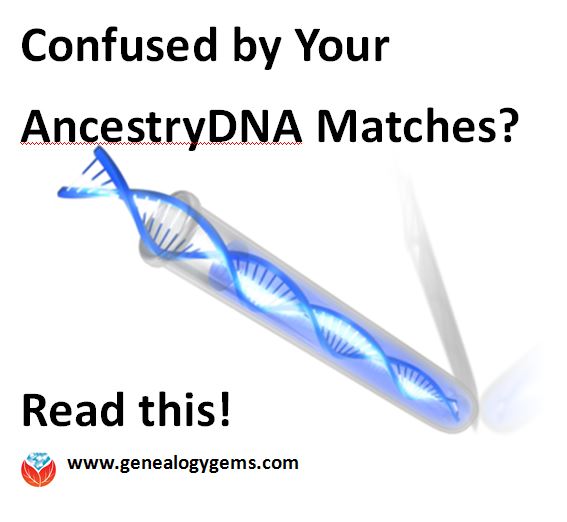 better understand and use those results. I know I’m not alone, since three of Diahan’s DNA posts made our Top 10 this year! (We covered #10 yesterday.)
better understand and use those results. I know I’m not alone, since three of Diahan’s DNA posts made our Top 10 this year! (We covered #10 yesterday.)
Click here to read the above post, and click here to find a list of all DNA-related posts on our genealogy blog.
 If you’ve done your homework and decided that an AncestryDNA test is what should be next for your family history research, thank you for purchasing one by clicking here. Your purchase supports the free Genealogy Gem blog and podcast. (Thank you! YOU are a gem!)
If you’ve done your homework and decided that an AncestryDNA test is what should be next for your family history research, thank you for purchasing one by clicking here. Your purchase supports the free Genealogy Gem blog and podcast. (Thank you! YOU are a gem!)
Disclosure: This article contains affiliate links and Genealogy Gems will be compensated if you make a purchase after clicking on these links (at no additional cost to you). Thank you for supporting Genealogy Gems!
by Lisa Cooke | Nov 16, 2015 | 01 What's New, Ancestry, DNA
I’m still a little bit bewildered as to how we got to 1000 genealogy blog posts! But here we are, and we are celebrating!
Our website has changed over the years to new platforms and web hosts, and our analytics don’t even go back to the very beginning. Therefore, I’m content with recapping your top 10 favorite blog posts of 2015, which was a significant year since almost 1/3 of the 1000 appeared in the last 11 months. This demonstrates our growing commitment to blogging about genealogy and bringing you the best GEMS we can find! So, here’s my take on a Casey Kasem-style TOP 10 Countdown of our most popular genealogy blog posts, starting with…#10!
I think it is pretty safe to sum up 2015 as the year of DNA. Genetic genealogy was a sizzling hot topic as Ancestry blazed a new trail, after abandoning mitochondrial and YDNA testing in 2014 and focusing all of its efforts on autosomal. Those efforts included a concentrated marketing campaign that resulted in a database of more than 1 million DNA testers.
When I first met Diahan Southard at a conference in Florida in March of 2014, I knew instinctively that she was a Genealogy Gem and immediately invited her to join our team. Now as Your DNA Guide she expertly navigates us all through the sometimes murky DNA waters. Through her blog posts and podcast segments, she helps us make sense of genetic genealogy through her warm and easy-to-understand style. So it is no wonder that the tenth most popular and widely read blog post on the Genealogy Gems blog was penned by Diahan on this very hot topic.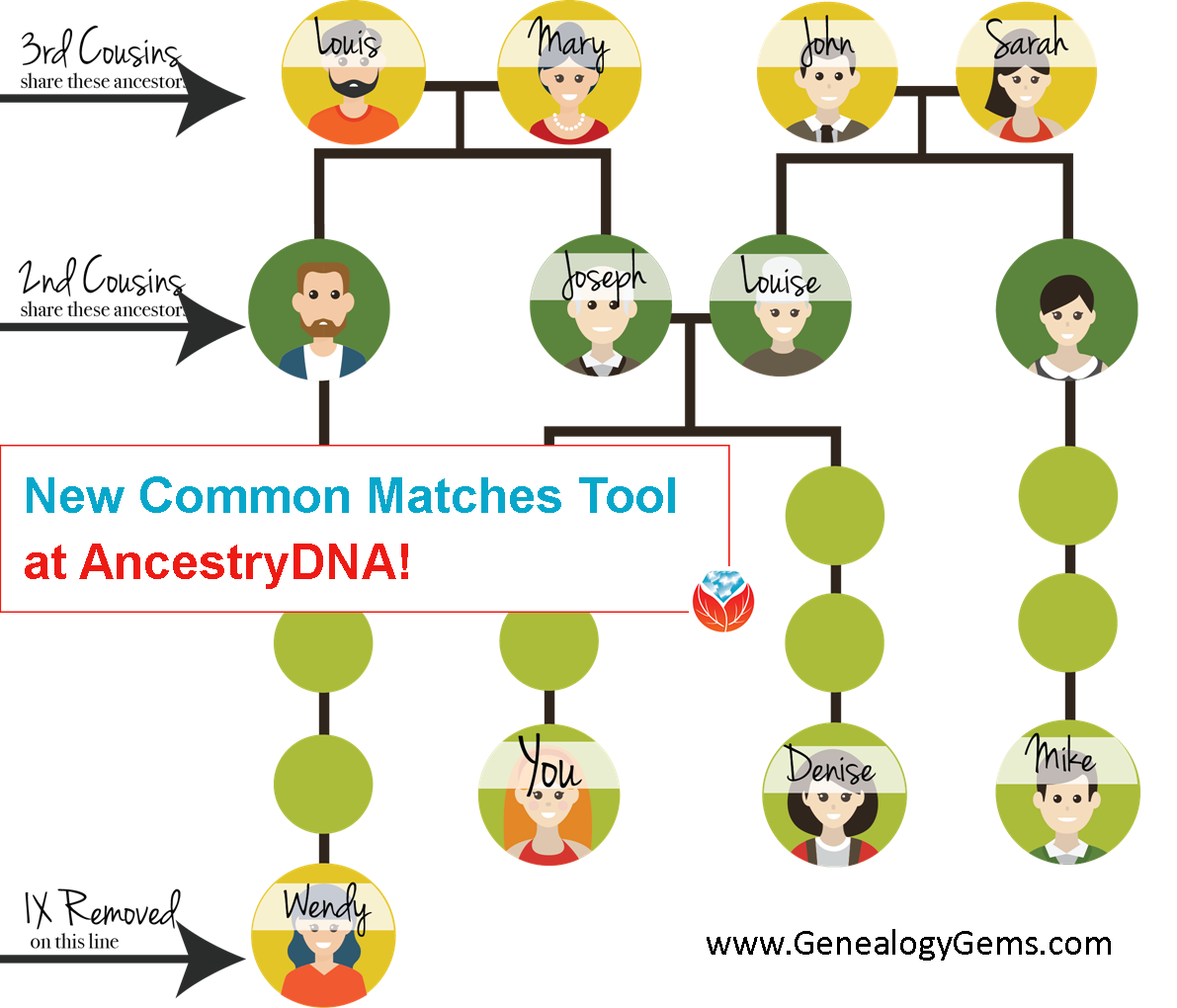
In the #10 genealogy blog post New AncestryDNA Common Matches Tool: Love it! Diahan reports on a fabulous online tool that pulls out shared genetic matches between two people at AncestryDNA. After hinting at what the Common Matches tool was doing for her own research…
A new tool at Ancestry DNA is blowing my genealogy mysteries wide open!
is blowing my genealogy mysteries wide open!
…Diahan lays out in a fun and easily digestible way how you can put it to work for you. It’s a great read or re-read – just click the link above.
Page 4 of 6« First«...23456»
 Double good news: AncestryDNA has made some improvements to the way they calculate your genetic matches, but they haven’t messed with the site format or layout. There is one downside–so keep reading.
Double good news: AncestryDNA has made some improvements to the way they calculate your genetic matches, but they haven’t messed with the site format or layout. There is one downside–so keep reading.
 Of those windows, you may share the “etch a pai” with another individual in the database, earning that cousin a spot on your match page. However, the truth is, that bit could say “sketch a painting” or “stretch a painful leg” or “fetch a pail.” With Ancestry’s new method, they are able to see farther on either side of the matching segment, making this clearly “fetch a pail.” That means better matching, which means more confidence in your cousin matches.
Of those windows, you may share the “etch a pai” with another individual in the database, earning that cousin a spot on your match page. However, the truth is, that bit could say “sketch a painting” or “stretch a painful leg” or “fetch a pail.” With Ancestry’s new method, they are able to see farther on either side of the matching segment, making this clearly “fetch a pail.” That means better matching, which means more confidence in your cousin matches. When DNA Circles DON’T Mean Connections on AncestryDNA
When DNA Circles DON’T Mean Connections on AncestryDNA

 If you enjoyed this post, you’ll love my series of DNA for genealogy quick guides. Each laminated guide–with quick, clear text that helps you act on what you learn–is targeted to a specific DNA topic, from “Getting Started” to the three types of DNA tests you can take to understanding your results with testing companies
If you enjoyed this post, you’ll love my series of DNA for genealogy quick guides. Each laminated guide–with quick, clear text that helps you act on what you learn–is targeted to a specific DNA topic, from “Getting Started” to the three types of DNA tests you can take to understanding your results with testing companies 
 Before doing any DNA test, we always encourage genealogists to do their homework. Different tests should be used for different genealogical questions. Each company offers unique tools, perks and sometimes drawbacks for genealogy customers. Unexpected results and unpredictable encounters with genetic relatives may be difficult for some. Diahan’s
Before doing any DNA test, we always encourage genealogists to do their homework. Different tests should be used for different genealogical questions. Each company offers unique tools, perks and sometimes drawbacks for genealogy customers. Unexpected results and unpredictable encounters with genetic relatives may be difficult for some. Diahan’s 
 better understand and use those results. I know I’m not alone, since three of Diahan’s DNA posts made our Top 10 this year! (We covered
better understand and use those results. I know I’m not alone, since three of Diahan’s DNA posts made our Top 10 this year! (We covered 





